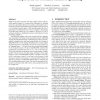Free Online Productivity Tools
i2Speak
i2Symbol
i2OCR
iTex2Img
iWeb2Print
iWeb2Shot
i2Type
iPdf2Split
iPdf2Merge
i2Bopomofo
i2Arabic
i2Style
i2Image
i2PDF
iLatex2Rtf
Sci2ools
PPOPP
2010
ACM
2010
ACM
Helper locks for fork-join parallel programming
Helper locks allow programs with large parallel critical sections, called parallel regions, to execute more efficiently by enlisting processors that might otherwise be waiting on the helper lock to aid in the execution of the parallel region. Suppose that a processor p is executing a parallel region A after having acquired the lock L protecting A. If another processor p tries to acquire L, then instead of blocking and waiting for p to complete A, processor p joins p to help it complete A. Additional processors not blocked on L may also help to execute A. The HELPER runtime system can execute fork-join computations augmented with helper locks and parallel regions. HELPER supports the unbounded nesting of parallel regions. We provide theoretical completion-time and space-usage bounds for a design of HELPER based on work stealing. Specifically, let V be the number of parallel regions in a computation, let T1 be its work, and let eT be its "aggregate span" -- the sum of the span...
Distributed And Parallel Computing | Helper Lock | Parallel Critical Sections | Parallel Regions | PPOPP 2010 |
| Added | 18 Oct 2010 |
| Updated | 18 Oct 2010 |
| Type | Conference |
| Year | 2010 |
| Where | PPOPP |
| Authors | Kunal Agrawal, Charles E. Leiserson, Jim Sukha |
Comments (0)

